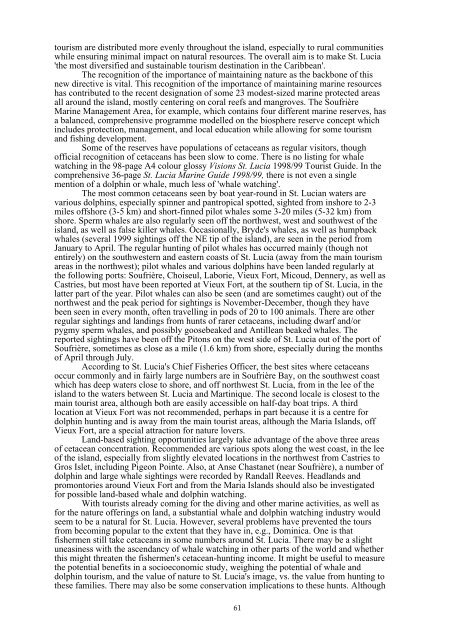The Potential of Whale Watching in the Caribbean: 1999+
The Potential of Whale Watching in the Caribbean: 1999+
The Potential of Whale Watching in the Caribbean: 1999+
Create successful ePaper yourself
Turn your PDF publications into a flip-book with our unique Google optimized e-Paper software.
tourism are distributed more evenly throughout <strong>the</strong> island, especially to rural communities<br />
while ensur<strong>in</strong>g m<strong>in</strong>imal impact on natural resources. <strong>The</strong> overall aim is to make St. Lucia<br />
'<strong>the</strong> most diversified and susta<strong>in</strong>able tourism dest<strong>in</strong>ation <strong>in</strong> <strong>the</strong> <strong>Caribbean</strong>'.<br />
<strong>The</strong> recognition <strong>of</strong> <strong>the</strong> importance <strong>of</strong> ma<strong>in</strong>ta<strong>in</strong><strong>in</strong>g nature as <strong>the</strong> backbone <strong>of</strong> this<br />
new directive is vital. This recognition <strong>of</strong> <strong>the</strong> importance <strong>of</strong> ma<strong>in</strong>ta<strong>in</strong><strong>in</strong>g mar<strong>in</strong>e resources<br />
has contributed to <strong>the</strong> recent designation <strong>of</strong> some 23 modest-sized mar<strong>in</strong>e protected areas<br />
all around <strong>the</strong> island, mostly center<strong>in</strong>g on coral reefs and mangroves. <strong>The</strong> Soufrière<br />
Mar<strong>in</strong>e Management Area, for example, which conta<strong>in</strong>s four different mar<strong>in</strong>e reserves, has<br />
a balanced, comprehensive programme modelled on <strong>the</strong> biosphere reserve concept which<br />
<strong>in</strong>cludes protection, management, and local education while allow<strong>in</strong>g for some tourism<br />
and fish<strong>in</strong>g development.<br />
Some <strong>of</strong> <strong>the</strong> reserves have populations <strong>of</strong> cetaceans as regular visitors, though<br />
<strong>of</strong>ficial recognition <strong>of</strong> cetaceans has been slow to come. <strong>The</strong>re is no list<strong>in</strong>g for whale<br />
watch<strong>in</strong>g <strong>in</strong> <strong>the</strong> 98-page A4 colour glossy Visions St. Lucia 1998/99 Tourist Guide. In <strong>the</strong><br />
comprehensive 36-page St. Lucia Mar<strong>in</strong>e Guide 1998/99, <strong>the</strong>re is not even a s<strong>in</strong>gle<br />
mention <strong>of</strong> a dolph<strong>in</strong> or whale, much less <strong>of</strong> 'whale watch<strong>in</strong>g'.<br />
<strong>The</strong> most common cetaceans seen by boat year-round <strong>in</strong> St. Lucian waters are<br />
various dolph<strong>in</strong>s, especially sp<strong>in</strong>ner and pantropical spotted, sighted from <strong>in</strong>shore to 2-3<br />
miles <strong>of</strong>fshore (3-5 km) and short-f<strong>in</strong>ned pilot whales some 3-20 miles (5-32 km) from<br />
shore. Sperm whales are also regularly seen <strong>of</strong>f <strong>the</strong> northwest, west and southwest <strong>of</strong> <strong>the</strong><br />
island, as well as false killer whales. Occasionally, Bryde's whales, as well as humpback<br />
whales (several 1999 sight<strong>in</strong>gs <strong>of</strong>f <strong>the</strong> NE tip <strong>of</strong> <strong>the</strong> island), are seen <strong>in</strong> <strong>the</strong> period from<br />
January to April. <strong>The</strong> regular hunt<strong>in</strong>g <strong>of</strong> pilot whales has occurred ma<strong>in</strong>ly (though not<br />
entirely) on <strong>the</strong> southwestern and eastern coasts <strong>of</strong> St. Lucia (away from <strong>the</strong> ma<strong>in</strong> tourism<br />
areas <strong>in</strong> <strong>the</strong> northwest); pilot whales and various dolph<strong>in</strong>s have been landed regularly at<br />
<strong>the</strong> follow<strong>in</strong>g ports: Soufrière, Choiseul, Laborie, Vieux Fort, Micoud, Dennery, as well as<br />
Castries, but most have been reported at Vieux Fort, at <strong>the</strong> sou<strong>the</strong>rn tip <strong>of</strong> St. Lucia, <strong>in</strong> <strong>the</strong><br />
latter part <strong>of</strong> <strong>the</strong> year. Pilot whales can also be seen (and are sometimes caught) out <strong>of</strong> <strong>the</strong><br />
northwest and <strong>the</strong> peak period for sight<strong>in</strong>gs is November-December, though <strong>the</strong>y have<br />
been seen <strong>in</strong> every month, <strong>of</strong>ten travell<strong>in</strong>g <strong>in</strong> pods <strong>of</strong> 20 to 100 animals. <strong>The</strong>re are o<strong>the</strong>r<br />
regular sight<strong>in</strong>gs and land<strong>in</strong>gs from hunts <strong>of</strong> rarer cetaceans, <strong>in</strong>clud<strong>in</strong>g dwarf and/or<br />
pygmy sperm whales, and possibly goosebeaked and Antillean beaked whales. <strong>The</strong><br />
reported sight<strong>in</strong>gs have been <strong>of</strong>f <strong>the</strong> Pitons on <strong>the</strong> west side <strong>of</strong> St. Lucia out <strong>of</strong> <strong>the</strong> port <strong>of</strong><br />
Soufrière, sometimes as close as a mile (1.6 km) from shore, especially dur<strong>in</strong>g <strong>the</strong> months<br />
<strong>of</strong> April through July.<br />
Accord<strong>in</strong>g to St. Lucia's Chief Fisheries Officer, <strong>the</strong> best sites where cetaceans<br />
occur commonly and <strong>in</strong> fairly large numbers are <strong>in</strong> Soufrière Bay, on <strong>the</strong> southwest coast<br />
which has deep waters close to shore, and <strong>of</strong>f northwest St. Lucia, from <strong>in</strong> <strong>the</strong> lee <strong>of</strong> <strong>the</strong><br />
island to <strong>the</strong> waters between St. Lucia and Mart<strong>in</strong>ique. <strong>The</strong> second locale is closest to <strong>the</strong><br />
ma<strong>in</strong> tourist area, although both are easily accessible on half-day boat trips. A third<br />
location at Vieux Fort was not recommended, perhaps <strong>in</strong> part because it is a centre for<br />
dolph<strong>in</strong> hunt<strong>in</strong>g and is away from <strong>the</strong> ma<strong>in</strong> tourist areas, although <strong>the</strong> Maria Islands, <strong>of</strong>f<br />
Vieux Fort, are a special attraction for nature lovers.<br />
Land-based sight<strong>in</strong>g opportunities largely take advantage <strong>of</strong> <strong>the</strong> above three areas<br />
<strong>of</strong> cetacean concentration. Recommended are various spots along <strong>the</strong> west coast, <strong>in</strong> <strong>the</strong> lee<br />
<strong>of</strong> <strong>the</strong> island, especially from slightly elevated locations <strong>in</strong> <strong>the</strong> northwest from Castries to<br />
Gros Islet, <strong>in</strong>clud<strong>in</strong>g Pigeon Po<strong>in</strong>te. Also, at Anse Chastanet (near Soufrière), a number <strong>of</strong><br />
dolph<strong>in</strong> and large whale sight<strong>in</strong>gs were recorded by Randall Reeves. Headlands and<br />
promontories around Vieux Fort and from <strong>the</strong> Maria Islands should also be <strong>in</strong>vestigated<br />
for possible land-based whale and dolph<strong>in</strong> watch<strong>in</strong>g.<br />
With tourists already com<strong>in</strong>g for <strong>the</strong> div<strong>in</strong>g and o<strong>the</strong>r mar<strong>in</strong>e activities, as well as<br />
for <strong>the</strong> nature <strong>of</strong>fer<strong>in</strong>gs on land, a substantial whale and dolph<strong>in</strong> watch<strong>in</strong>g <strong>in</strong>dustry would<br />
seem to be a natural for St. Lucia. However, several problems have prevented <strong>the</strong> tours<br />
from becom<strong>in</strong>g popular to <strong>the</strong> extent that <strong>the</strong>y have <strong>in</strong>, e.g., Dom<strong>in</strong>ica. One is that<br />
fishermen still take cetaceans <strong>in</strong> some numbers around St. Lucia. <strong>The</strong>re may be a slight<br />
uneas<strong>in</strong>ess with <strong>the</strong> ascendancy <strong>of</strong> whale watch<strong>in</strong>g <strong>in</strong> o<strong>the</strong>r parts <strong>of</strong> <strong>the</strong> world and whe<strong>the</strong>r<br />
this might threaten <strong>the</strong> fishermen's cetacean-hunt<strong>in</strong>g <strong>in</strong>come. It might be useful to measure<br />
<strong>the</strong> potential benefits <strong>in</strong> a socioeconomic study, weigh<strong>in</strong>g <strong>the</strong> potential <strong>of</strong> whale and<br />
dolph<strong>in</strong> tourism, and <strong>the</strong> value <strong>of</strong> nature to St. Lucia's image, vs. <strong>the</strong> value from hunt<strong>in</strong>g to<br />
<strong>the</strong>se families. <strong>The</strong>re may also be some conservation implications to <strong>the</strong>se hunts. Although<br />
61
















